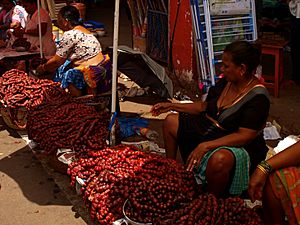Goan sausage facts for kids
The Goan sausage, also known as chorise, is a special type of sausage from Goa, a region in India. Goa used to be part of Portuguese India, and this sausage shows the mix of Indian and Portuguese cooking styles. It's based on the chorizo sausage, which came from Portugal.
Because Goa has a humid climate, it was hard to make European-style sausages that would last a long time. So, people learned to pickle the meat in vinegar, alcohol, and a spicy chili mix. Then, they put it into pig intestines, which act as the sausage skin. This makes the Goan sausage similar to the Spanish Chorizo, as both use a special process called "pimenton" to add flavor and help preserve them.
Making Goan Sausage
Making Goan sausage starts with large pieces of pork without bones. These pieces are sliced or chopped and then heavily salted. The chopped meat is left to dry in the sun for one or two days.
After drying, a mix of spices, ground hot chili peppers, palm vinegar, and a local drink called feni are added. Once the meat is mixed with these ingredients, it is put into casings (the outer skin of the sausage). The sausages are then dried in the sun again or slowly smoked.
Traditionally, these sausages are made during the dry season, usually from December to March. People eat more of them during the monsoon season, when it's harder to find fresh fish. Goan sausages are also a good source of protein.
How People Eat Goan Sausage
Goan sausage is a very flexible food. You can find it sold everywhere, from street food carts to fancy restaurants. It's used in many dishes like sandwiches, stews, and even as fillings in bread or soups. You can also eat it by itself with rice.
Choris pão or sausage buns are very popular snacks. To make choris pão, the sausages are chopped up, sometimes with onions and a little bit of curry. This mix is then placed inside a poi, which is a local Goan bun. The poi is chewier than the pav bun found in other parts of western India. Choris pão is a popular fast food sold by vendors during religious festivals or in cafes. It's a special snack often bought and eaten during the feast of St. Francis Xavier in Old Goa. Sausage buns are a more modern version where the sausage is baked right inside the bun. You can find these in most cafes and restaurants.
Sometimes, minced (finely chopped) sausages are also stuffed and fried between layers of flatbreads like parathas and naans. Even though these flatbreads are not originally from Goa, you often see dishes with Goan sausage and parathas or naans on restaurant menus there.
In Goan homes, sausages are often crumbled or cut and added to curries, stews, and chilly fry (a dish of vegetables and meat, usually beef). They are also used in pulão or pulav to add flavor and protein.
See also
 In Spanish: Chorizo de Goa para niños
In Spanish: Chorizo de Goa para niños



